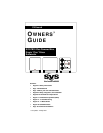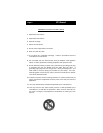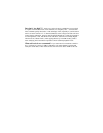
SV Sound
Page 8
goes to most appropriate speakers, and use the subwoofer correctly too.
“Small” is nearly always the best setting for today’s speakers. Also, is
your subwoofer turned “ON”? We don’t mean “is your subwoofer
ampli-
fier
on?” (that’ll be important later too) but rather,
is your receiver send-
ing a bass signal to your sub amp
? This can only happen if you say
“Yes” (or “ON”) in the “Subwoofer” selection during the setup of any
typical Dolby Digital/DTS capable receiver (you’ll need to enter your re-
ceiver’s setup “menu” to check these critical choices).
•
Is your receiver connected to the sub amp?
Use a well-shielded RCA
cable (sometimes called a “patch cord”) to connect the subwoofer output of your
DD/DTS receiver to
either
input jack of your SVS’s dedicated amp. Again, you’ll
need to “split” the bass signal with a “Y Cable” if you have a pair of subs. You
only need feed
one
of the two inputs (either Right or Left) of any
Powered Box SVS sub, these inputs are “summed” internally.
•
Is your Radio Shack
®
sound pressure level (SPL) me-
ter ready?
This tool is absolutely essential to proper home
theater audio setup. It’s akin to a tire pressure gauge for your car
(you don’t set your tires by “feel” right?). Set the meter to “Slow”
and “C-weighting” (and turn the dial to 70 or 80dB depending on
your test tone source). Haven’t got the meter yet? Order one
from your dealer, or SVS. We prefer the analog instead of the
digital display model.
Getting ready to start now: Make sure your receiver/processor master volume is set
at “00 dB” or some other easy to remember “reference level”. Finally, ensure your
SVS’s volume/gain control is set no more than 1/4 to 1/3rd up, for now. It’s also criti-
cal to check the subwoofer level control of your surround receiver before you begin the
test tones. Set the receiver’s subwoofer output signal no higher than “-6 dB” initially
(that’s one quarter way up, given a typical receiver’s channel level limits of –12 dB to
+12 dB) . Your LFE “trim” or “peak limiter”, if you have one, should be set to 0dB
(with the least effect). This can be changed later if needed. Turn off any sound-field
processing schemes, “mid-night mode”, “DRC” (dynamic range control) etc. If it is an
option in your system, route your LFE to the “Subwoofer only”, not “Mains + Sub”.
Now play your receiver's internal test tones so you have something to measure
with your SPL meter. Or, better yet, buy a test DVD such as the Avia. A test disk’s
tones ensure your entire signal path, from the DVD player to your speakers, is set cor-
rectly. Whatever you use, when the tones start alternating from speaker to speaker
(watch your sound meter now), set each speaker’s volume to about 75 dB (or 85dB if
using Avia) by using the receiver’s dedicated channel level controls (leaving receiver’s
master volume the same). We recommend you turn down the receiver’s subwoofer
output level before you significantly lower your sub’s volume/gain control. This helps
keep distortion sent to your SVS at a minimum. You should not be set this control
much lower than –6 dB however, since some downward adjustment maybe be needed
to fine tune levels later. If your subwoofer reading is still too high, then turn down the
sub’s amp volume a little with each run.


















